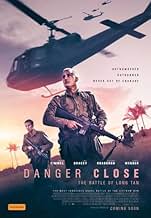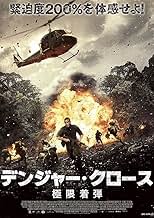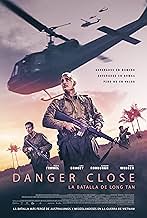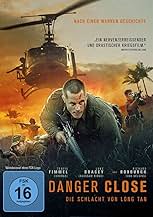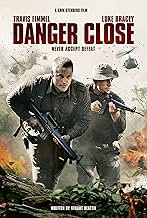En agosto de 1966, en una plantación de caucho vietnamita llamada Long Tan, 108 soldados jóvenes y en su mayoría sin experiencia que vienen de australia y nueva zelanda luchan por sus vidas ... Leer todoEn agosto de 1966, en una plantación de caucho vietnamita llamada Long Tan, 108 soldados jóvenes y en su mayoría sin experiencia que vienen de australia y nueva zelanda luchan por sus vidas contra 2500 soldados norvietnamita y Viet Cong soldados.En agosto de 1966, en una plantación de caucho vietnamita llamada Long Tan, 108 soldados jóvenes y en su mayoría sin experiencia que vienen de australia y nueva zelanda luchan por sus vidas contra 2500 soldados norvietnamita y Viet Cong soldados.
- Dirección
- Guionistas
- Elenco
- Premios
- 8 premios ganados y 6 nominaciones en total
- Gunner Murry Watene
- (as Richard Te Are)
Opiniones destacadas
If I have a criticism it would be what director Kriv Stenders himself was worried about when he showed the film to the real Harry Smith and veterans of the battle. Stenders was concerned "... that a cinematic interpretation of the film, overdramatizing some moments and fictionalizing others, would be an issue with veterans of the battle".
Although Harry Smith told Stenders he thought the film was great, I feel those scenes, especially the exchanges between Major Smith (Travis Fimmel) and Private Large (Daniel Webber), the stereotypical "Hollywood" stuff, do sound a false note. However, the film is a technical triumph with a superb score and, for the most part, seems honest to events.
The film is similar to Mel Gibson's "We Were Soldiers": the unexpected enemy force; the cut-off platoon; helicopter pilots defying orders to provide aid and impressive firepower that doesn't overshadow the discipline and guts of the troops on the ground. Both were straightforward battles without civilians caught in the crossfire.
As an Australian, I'm not sure how non-Australian audiences will view "Danger Close". The accents could be challenging and the look of the Australians and New Zealanders is noticeably different to the helmeted U.S. Army and Marines familiar from documentaries and newsreels. Ever since the war, the respective tactics of the allies have been dissected in books and back-and-forth sessions on military history blogs. The Diggers of that era actually looked like the U.S. Army LRRPs or even the VC; styled for jungle warfare.
Another thought, a great victory is only in proportion to the toughness of the enemy. All accounts I've read also acknowledge the bravery of the Vietnamese. You do see it in the film, but it could have been stated.
Despite the rights and wrongs of Australia's involvement, Long Tan has emerged as one of our most iconic battles. Maybe it's partly guilt over the way Vietnam veterans were neglected for so long. Maybe it's also because not much was expected of the "Baby Boomers", but they stood up nonetheless.
Like Peter Weir's "Gallipoli", "Danger Close" will probably be how future generations will know this battle. With that in mind, the filmmakers and the stars, despite the odd flaw, have left us with a powerful and affecting experience.
During the battle of Long Tran, 108 Australian and New Zealand soldiers held off a North Vietnamese force of over 2000. 18 Australians and an estimated 245 Vietnamese lost their lives.
The terrain and the artillery pieces looked quite different as they are shown in the movie. Filming Locations: Village Roadshow Studios, Oxenford, Queensland, Australia. The SLR rifles looked real, but the M16s were not E-1s or E-2s; actually, the 16 rifles were not introduced to the Australian Army until 1967. You could use the flash suppressor of the E1 to break the bands on "c-ration" cases. I still have an AR15.
However, this is a movie, and it does not have to be factual. It is the people integration that makes or breaks this movie for the viewer. Oh, yes and there is a lot of action for those that like a lot of action.
Talking about action, we get an APC charge that looks like Tarzan and the elephants at the last minute. The only problem with that is that no one would be caught in an APC. We always rode on top (usually including the driver) as one good RPG shot would burn a good two-inch hole in the aluminum hull on its way through. I had to clean up body parts from an RPG that went through the driver and into the engine compartment taking a lot of drivers with it.
The U. S. military was not as professional at the time, but they were disciplined and not arrogant as the soldiers in this movie are portrayed.
You get to hear "These Boots Are Made for Walkin'" Artist: Nancy Sinatra Release year: 1966
"He's my Blond-Headed, Stompie-Wompie, Real Gone Surfer Boy" (1964) Emmy Dougall played the singer Little Pattie
Also, you get to hear "I was only 19 (a Walk in the Light Green)" by John Schumann.
In memory of those members of D COY and 3TP IACP Sqn who gave their lives during the Battle of Long Tan on 18th August 1966.
To make the movie entertaining they added fictional characters and incidents.
Be sure to watch the credits.
I will be watching again mainly to figure out what was missing but still a great film for anyone who loves reasonably accurate and terrifying historical situations. The battle scenes were incredible and the linking of the NZ artillery was exceptional.
I don't view historical films as a statement on the rights and wrongs of the time so it felt real to me from the perspective from which it was told.
¿Sabías que…?
- TriviaThe term, "Roger that", is an Americanism, originally from CB radio culture, and often used in military movies. However, it would never be said (or permitted, by any NCO or Officer within earshot) in the Australian Army. "Roger" is the only accepted proword. Similarly, the phrase, "I repeat", when repeating some for clarity over the radio telephone (RATEL), is not permitted. Instead the operator would use, "I say again...". This is because "repeat" is a proword used when directing artillery or naval fire (e.g "request for the same volume of fire to be fired again with or without corrections or changes")
- ErroresThe entire battle took place in a torrential tropical downpour from start to finish. Evidently, this would be hard to film for dramatic purposes. The airstrike never happened not because of a dud smoke grenade, but the cloud was so low and rain so intense the pilots could not identity the target area.
- Citas
Major Harry Smith: There's a thousand ways to die in a war zone.
- Créditos curiososPart way through the final credits, after showing the actors and pictures of their real life counterparts and some of the principal credits, acknowledgment of the 6RAR's Presidential Unit Citation from the USA made in 1968 but that Australia took 45 years to acknowledge the soldiers who fought in a similar way.
This is followed by an Honour Roll of the Australian Soldiers killed during this battle.
- ConexionesFeatured in Danger Close: Behind the Scenes (2019)
Selecciones populares
- How long is Danger Close?Con tecnología de Alexa
Detalles
Taquilla
- Presupuesto
- AUD 24,000,000 (estimado)
- Total a nivel mundial
- USD 2,092,198
- Tiempo de ejecución1 hora 58 minutos
- Color
- Relación de aspecto
- 2.35 : 1
Contribuir a esta página









